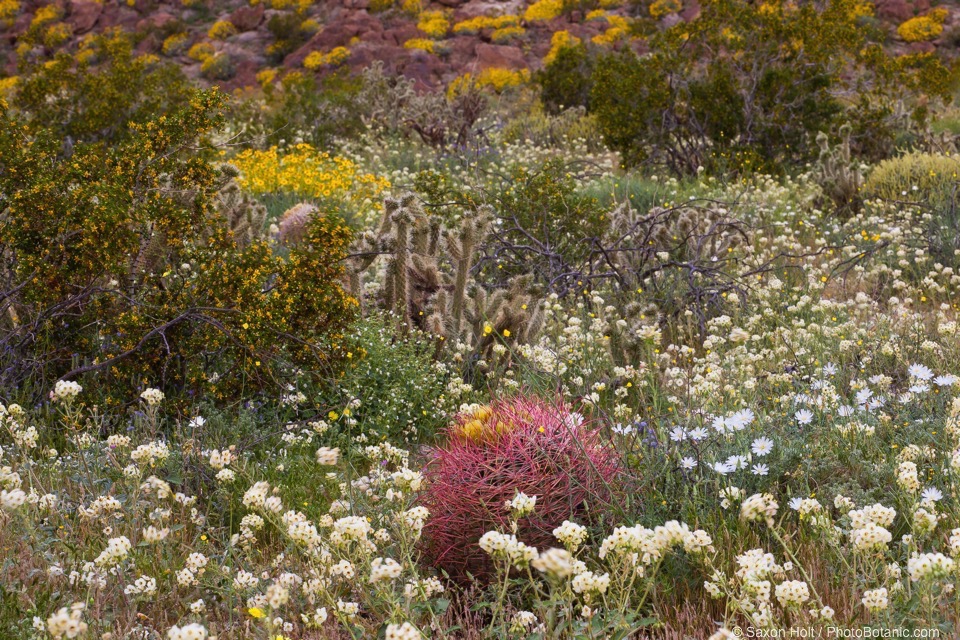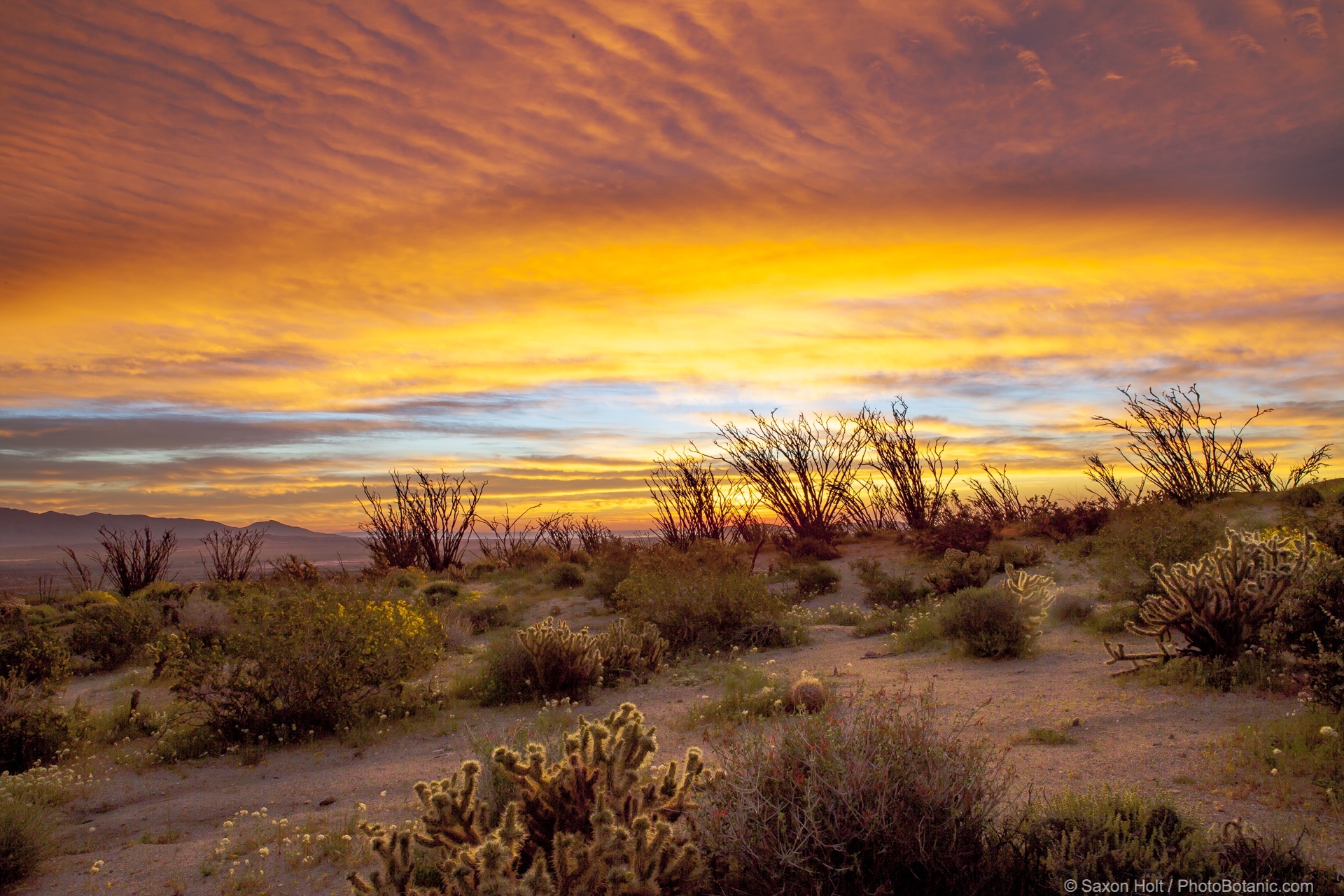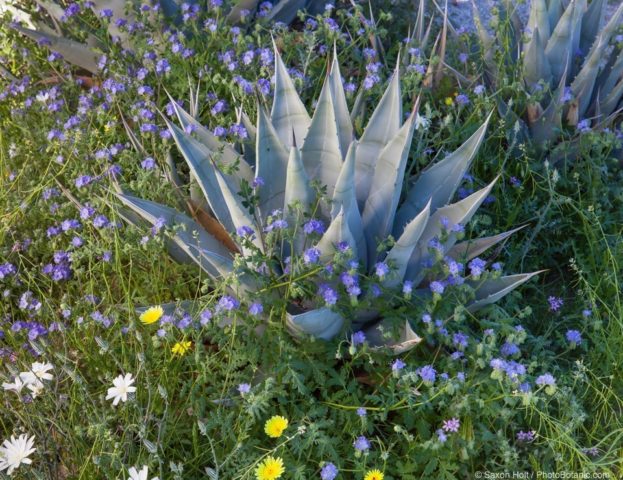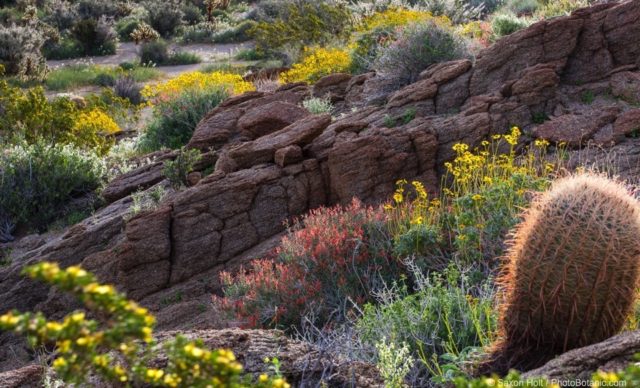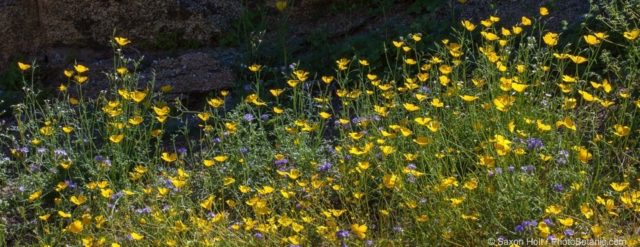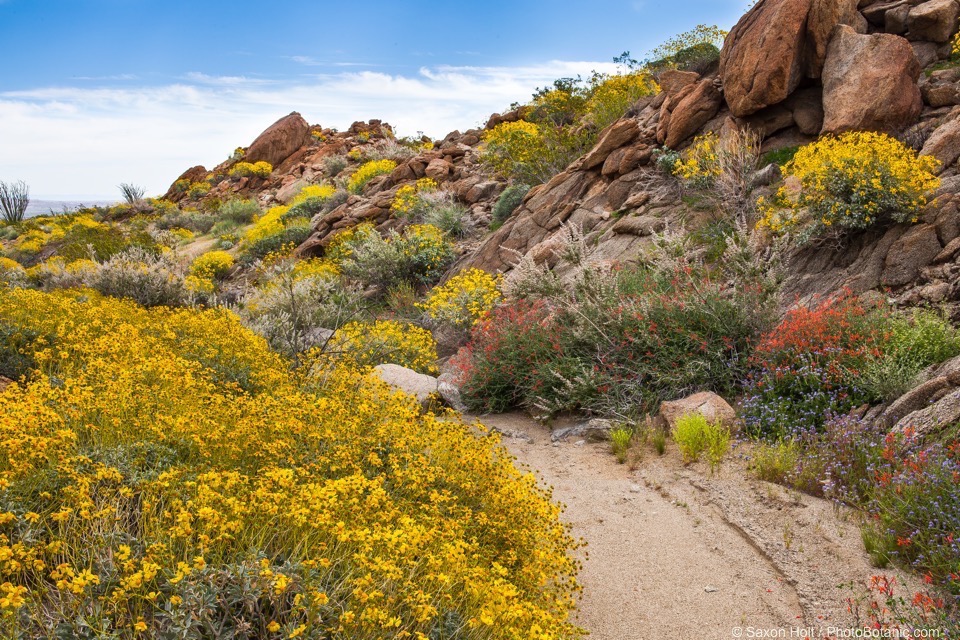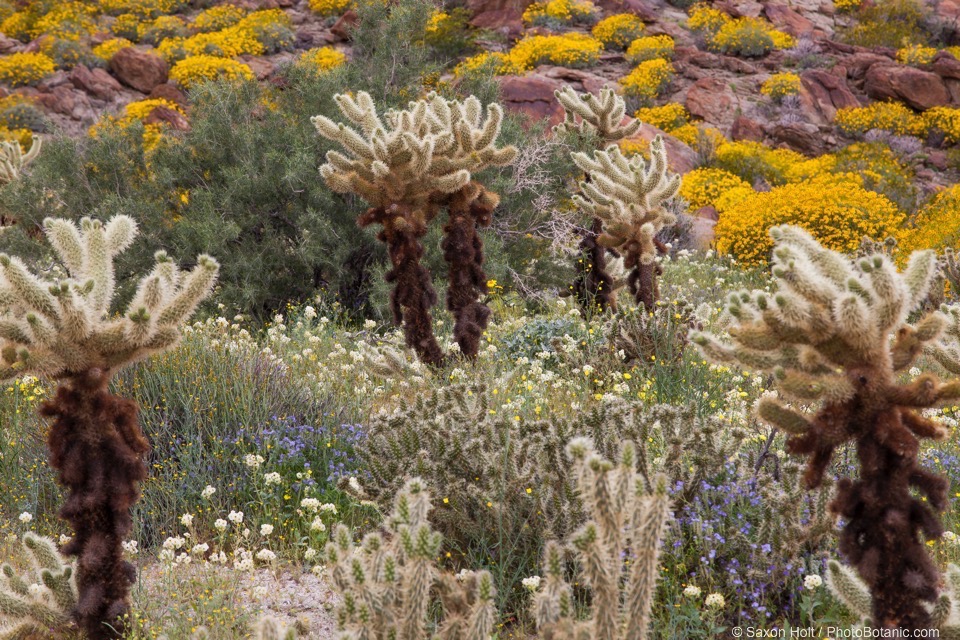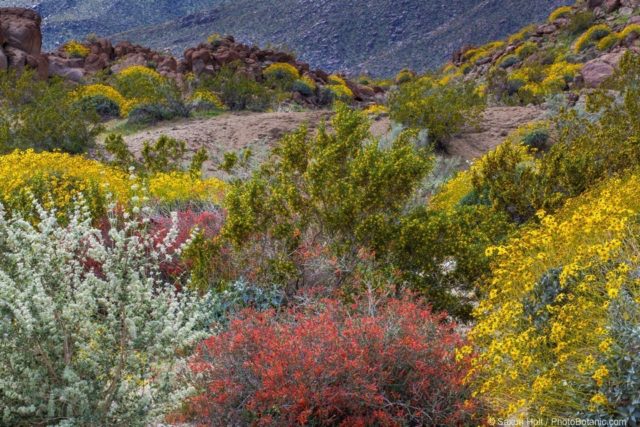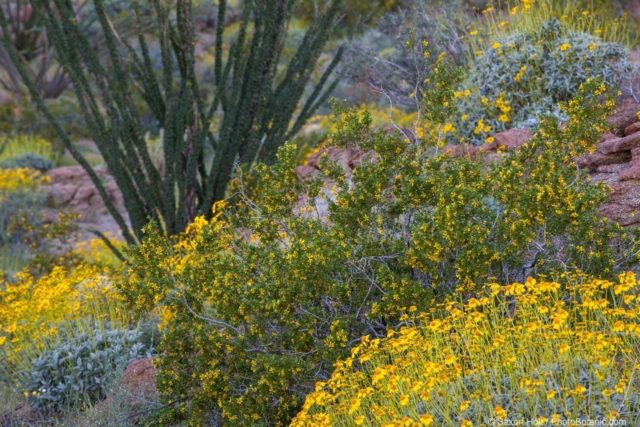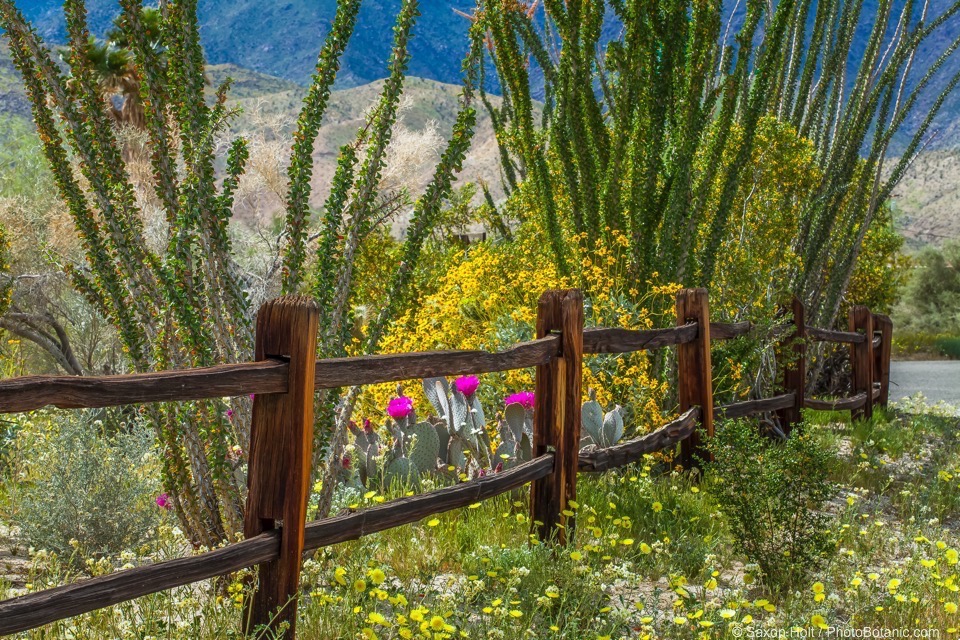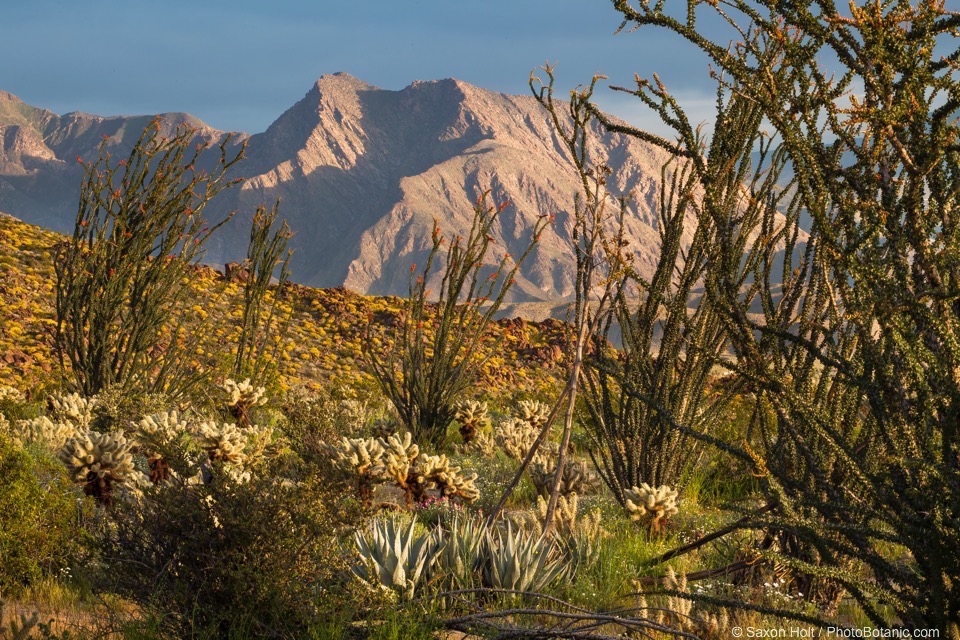This past spring I witnessed the superbloom in the California deserts. It was a sensation.
The superbloom began in late winter in the southern most deserts and progressed northward, a result of ample rain after five years of drought.
I was particularly intrigued, and made two separate visits to the Sonoran Desert east of San Diego in the most southern part of California at Anza Borrego State Park, where the good winter rains brought a spectacle of bloom that, in turn, brought tens of thousands of gawking flower lovers to the desert.
Most folks were drawn to the vast fields of annual wildflowers that carpeted the broad valley floors between mountain ranges, but as a gardener I was attracted to the mix of perennials, shrubs, and cactus that were also having a superbloom.
Truly this was Gardening Gone Wild; and there was much for a gardener to learn about how nature combines plants, how she covers the ground, how the natural spacing and heights of plants work in the wild.

Desert landscape of California native plants in early morning, Glorietta Canyon, Anza Borrego State Park
Before I became a garden photographer, and as I came to appreciate native plants, I took photographs that I hoped would inspire gardeners to bring native beauties into their gardens. Now when I photograph the native landscape, I can’t help but see the gardens that nature creates.
I saw gardens everywhere in the Sonoran Desert.

Evening light on the Sonoran Desert – Anza Borrego State Park, superbloom March 22, 2017 with Brittlebush, Ocotillo, and Barrel Cactus
I had never been to the desert for a superbloom and admit to being astonished by the acres of perennials and shrubs that were enjoying a spectacular year along with the annual wild flowers. I felt like the proverbial kid in the candy store, treats everywhere.
I camped on a dirt road away from any trails and at first light just walked into this dream, eyes wide, alert to nature’s plant combinations.
Actually, first light was stunning and I took a few pictures before I ventured out into the desert.
To me, the highest form of garden plant design is the art of a mixed border, where different types of plants are combined to fill the vertical and horizontal spaces with complimentary shapes and colors. Here is how Mother Nature interprets the mixed border in the desert.
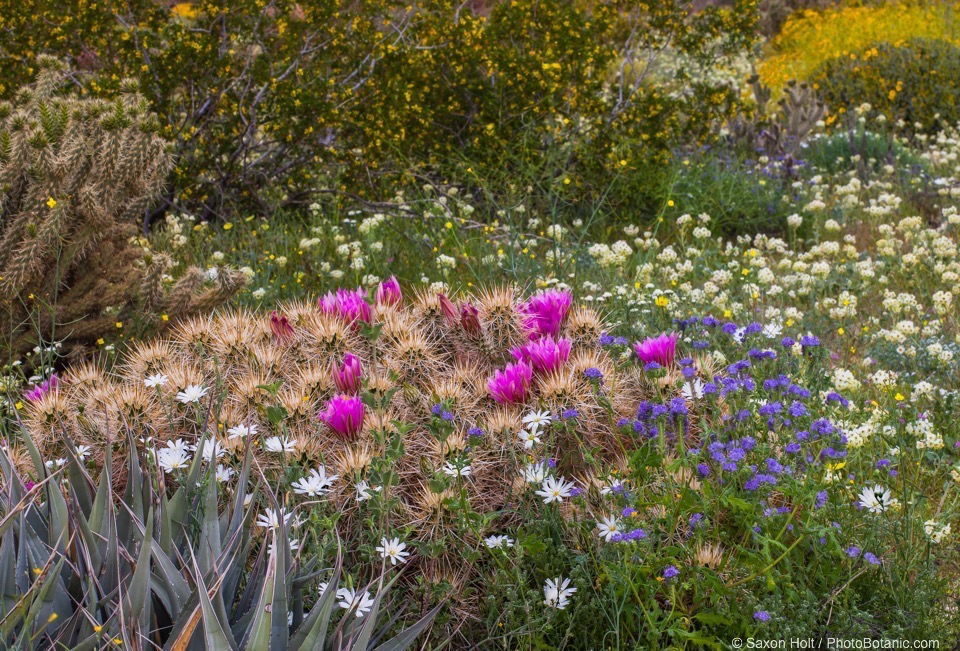
Natural desert garden – Hedgehog Cactus flowering with Desert Chicory, Brown-eyed Primrose Creosote Bush, and Blue Phacelia
Against the background of the tall dark green, yellow flowering Creosote Bush this tapestry of succulent cactus and annual wild flowers would make any desert gardener envious. All that is needed to make this a garden in the real desert is the camera to frame it.
Cactus have become increasingly popular in drought tolerant gardens (anyone noticed Debra Lee Baldwin’s posts here ?), and garden designers often suggest softening their tough spiky look by planting annuals around them. Perhaps as seen here in the wild ?
As I wandered in the desert looking for photographs I found myself working into the canyons and washes where the rocks provided background and shelter from the bright sun. The rock formations helped create a sense of intimacy and also provided a bit of scale whereby I could really start to see garden vignettes, contained.
As the light streams into a garden a photographer looks for any opportunity to use backlight against a shadowed wall, as I did with these poppies in this sheltered desert canyon.
The narrow canyons provided great opportunities to see plants with rockwork and the natural erosion that was deposited in the dry washes created soft pathways of the finest crushed rock.
Along these pathways we see borders of flowering perennials spilling out on the paths against the background of the rock walls.
Back in the larger canyons with more flat bottomland I sought out taller plants to frame my compositions, just as a gardener might design with vertical punctuation points to help organize the garden. These Teddy Bear Cholla cactus (Cylindropuntia bigelovii) bear no resemblance to the little pots we so often see in nurseries.
I particularly began to notice the shrubs as they are the backbone any good garden. While the wildflowers grab attention of the superbloom it was the profusely flowering shrubs that made me see the gardens in the desert.
They, too we’re having a spectacular bloom, and where they grew together I saw the potential for shrub borders. Here, gray foliage Bushmint (Condea emoryi), red flowering Chuparosa (Beloperone californica), the ever present Brittlebush (Encelia farinosa), and the durable dark green Creosote Bush (Larrea tridentata) with its yellow flowers tying everything together create a beautiful, sustainable, drought tolerant, desert garden composition.
Because the Creosote Bush was having its own super bloom I noticed it everywhere. It’s yellow flowers helped it blend easily with the brittlebush that was covering the hillsides with gold.
Here with the Ocotillo (Fouquieria splendens), one of the signature plants of the desert, we see a wild mixed border.
The Ocotillo is a prized in many desert gardens; it’s explosion of vertical limbs is graphic and stunning. It’s tough to grow well outside of the desert because it requires hot dry soil with fast drainage.
But of course this is a trick of any naturalistic garden, finding plants that are naturally adapted. Any of these vignettes I found in the desert would qualify as a garden. All that’s needed to define the garden is to add a bit of human construct to make it look a bit tame and intentional. Perhaps a fence to claim it ?
I found this “real” garden as I drove through the small town of Borrego Springs, the headquarters of Anza Borrego State Park. This garden, effortless in Borrego Springs, would be virtually impossible to do and the sprawling cities along the heavily populated, coastal regions of California. Here in this place, the gardener simply embraced the native landscape. This is a brilliant idea for those who live in these types of areas. For those living in Arizona, Nevada and other desert climates (Middle East
comes to mind), https://desertplantguide.com/ has a great list of all the plants that can
grow in sand and hot conditions so it’s well worth a look at the improve your garden.
Learn more on how Anza Borrego got its name on this post I did for PhotoBotanic.
“On March 15, 1774 and December 24, 1775 Juan Bautista de Anza, leading expeditions from Mexico into Alta California, camped in Coyote Canyon in Anza-Borrego State Park – where I too camped my last night of documenting the 2017 superbloom.” For those partial to spotting some wildlife, this might not be a bad place to use one of the best electronic coyote call products on the market to get a better look at coyotes in their natural habitat.
Photo Gallery of Anza Borrego superbloom


